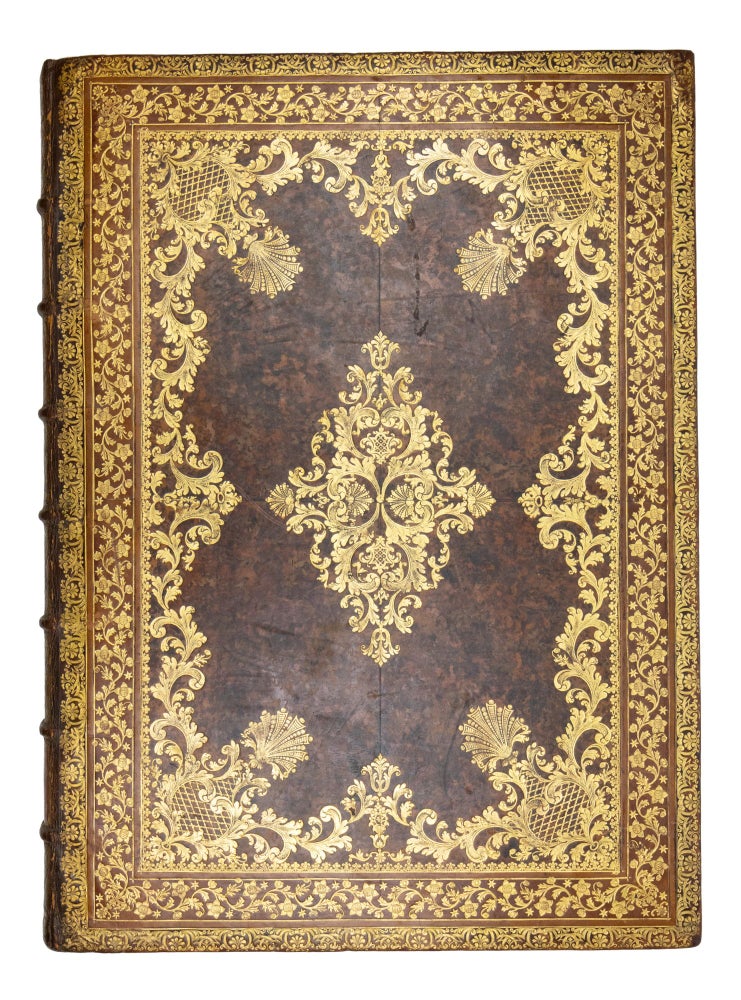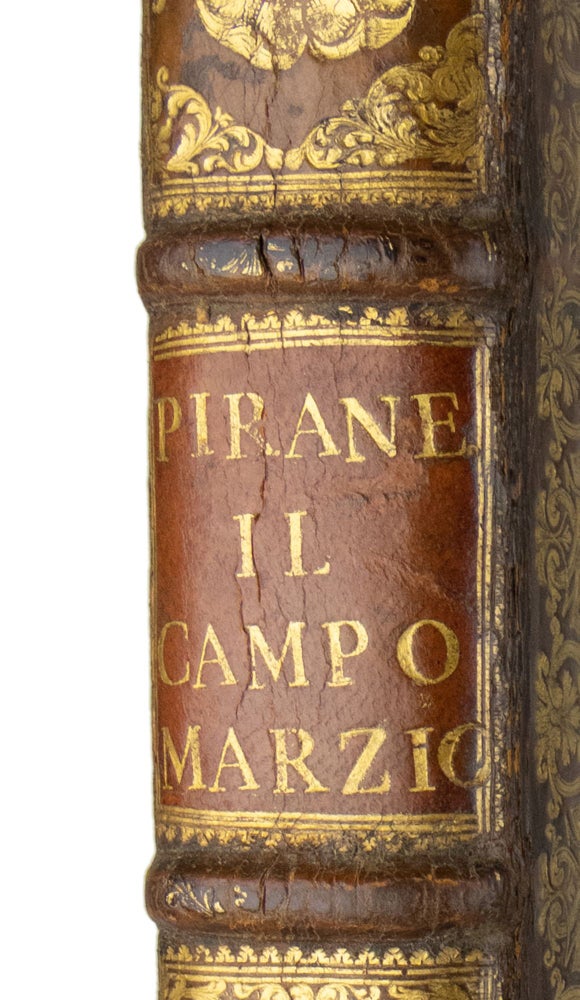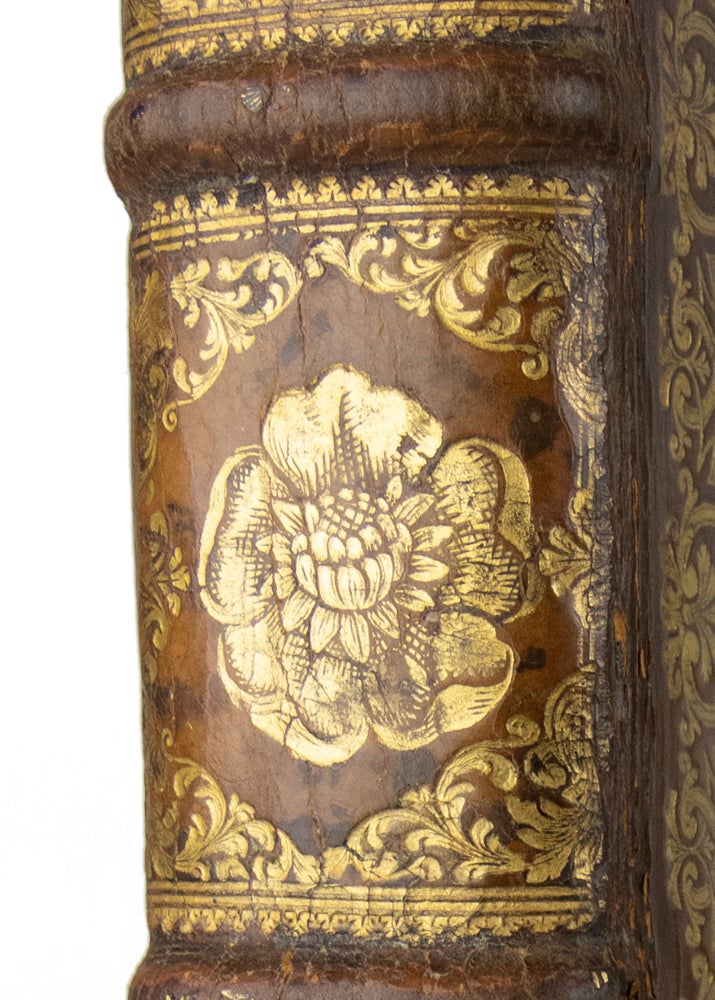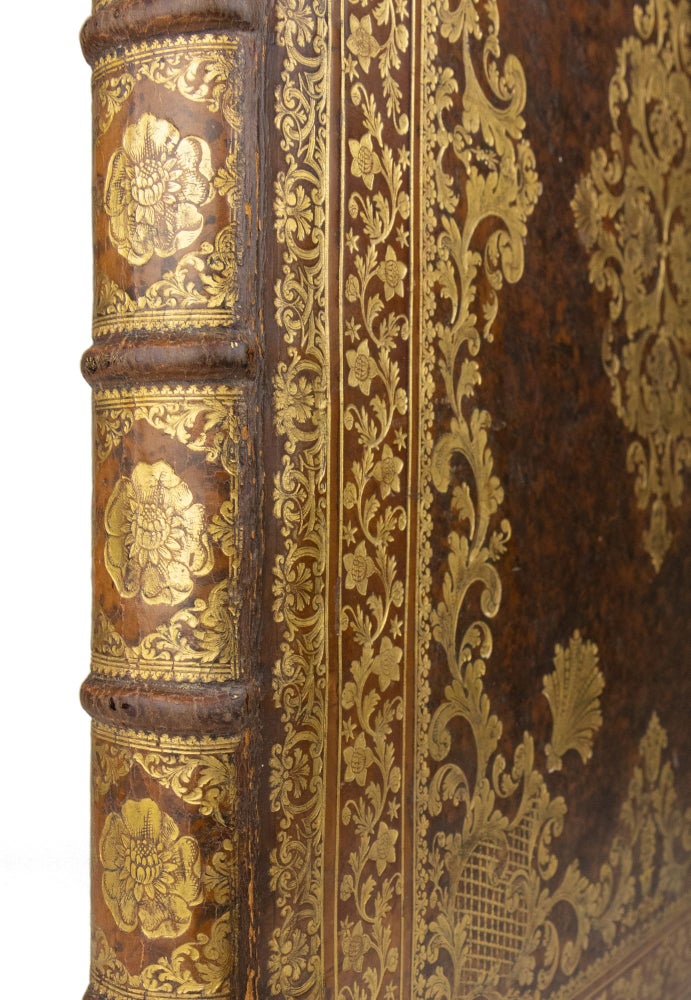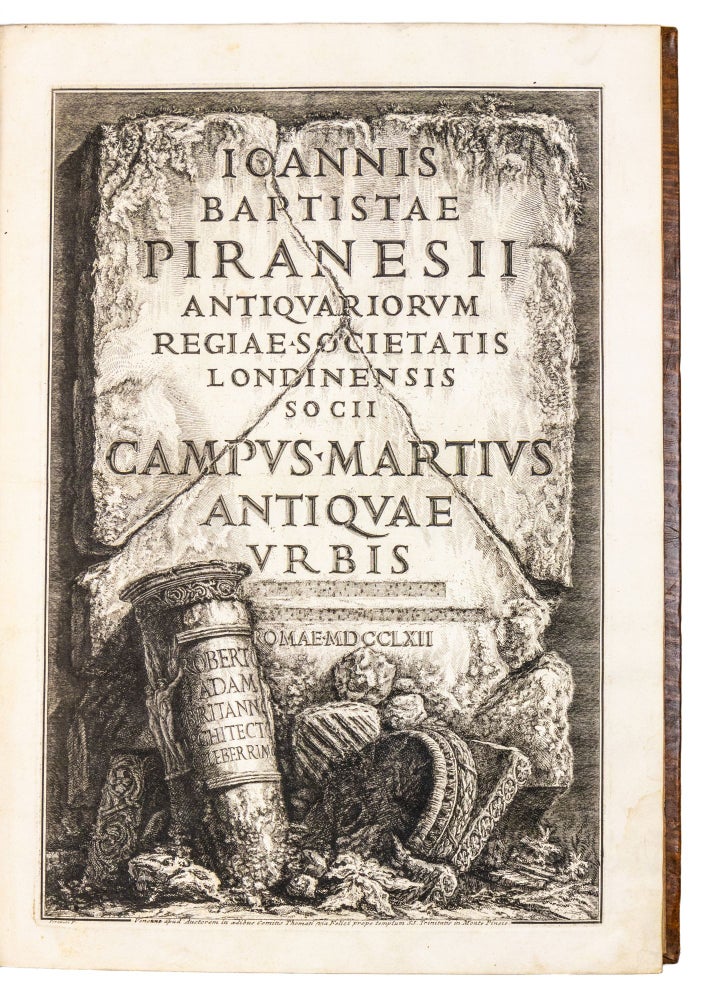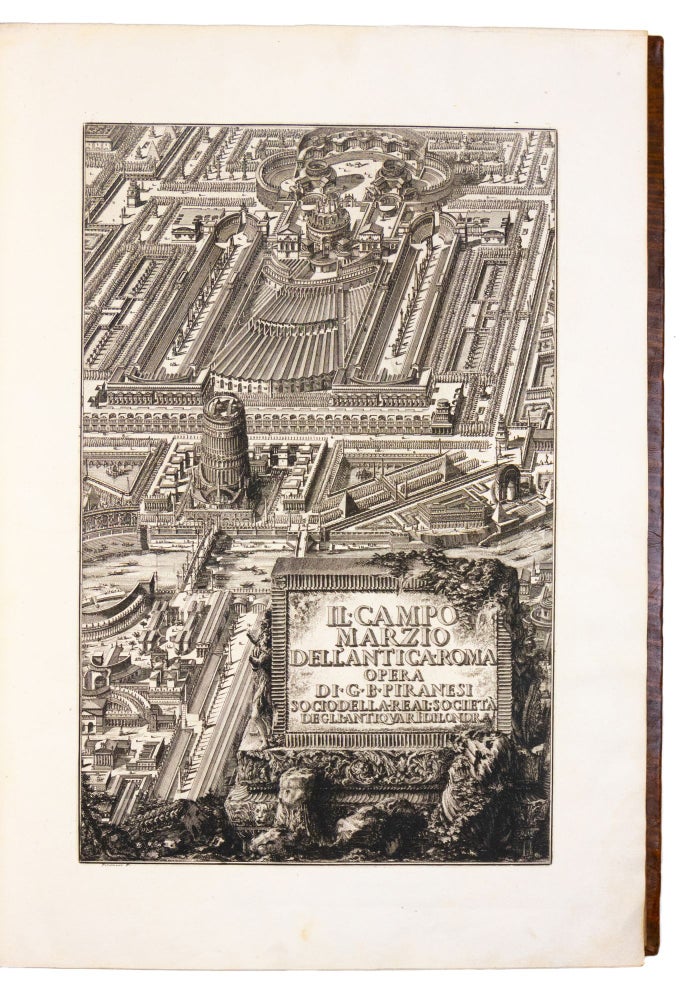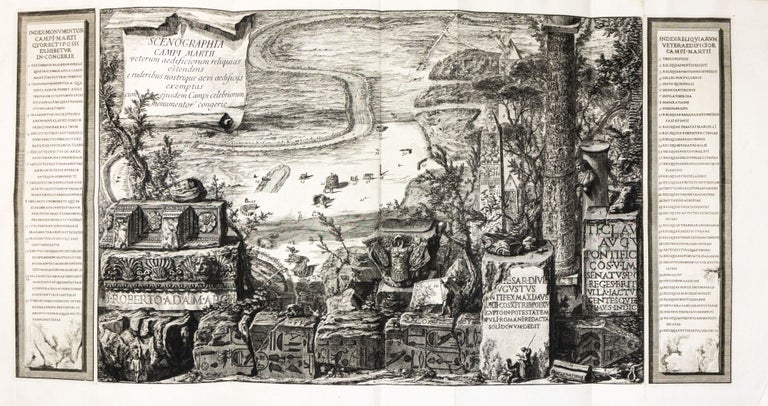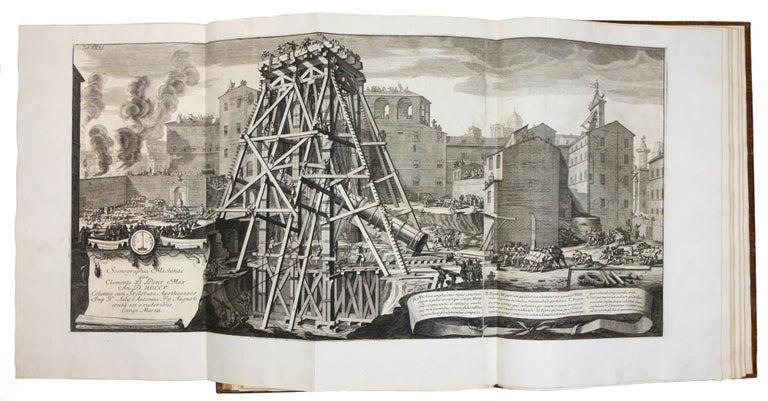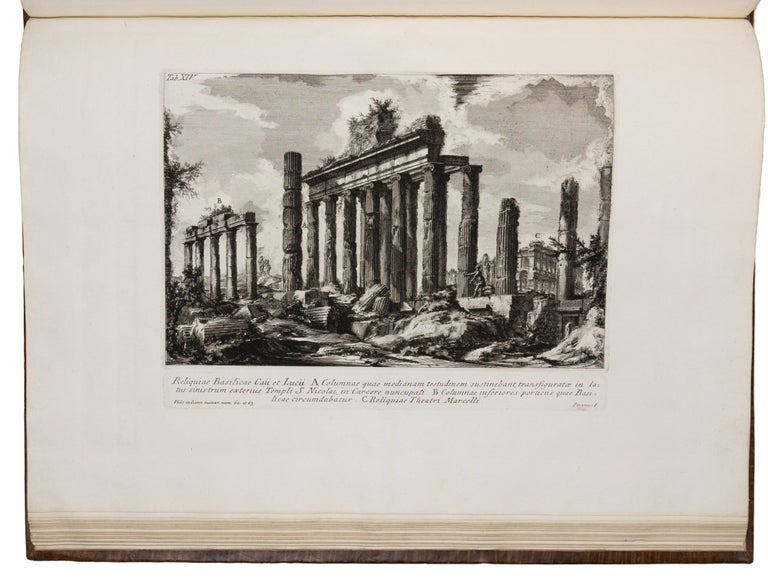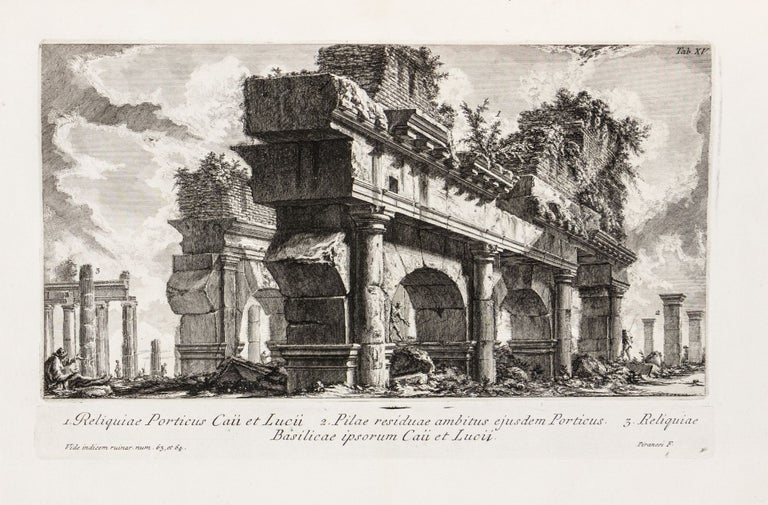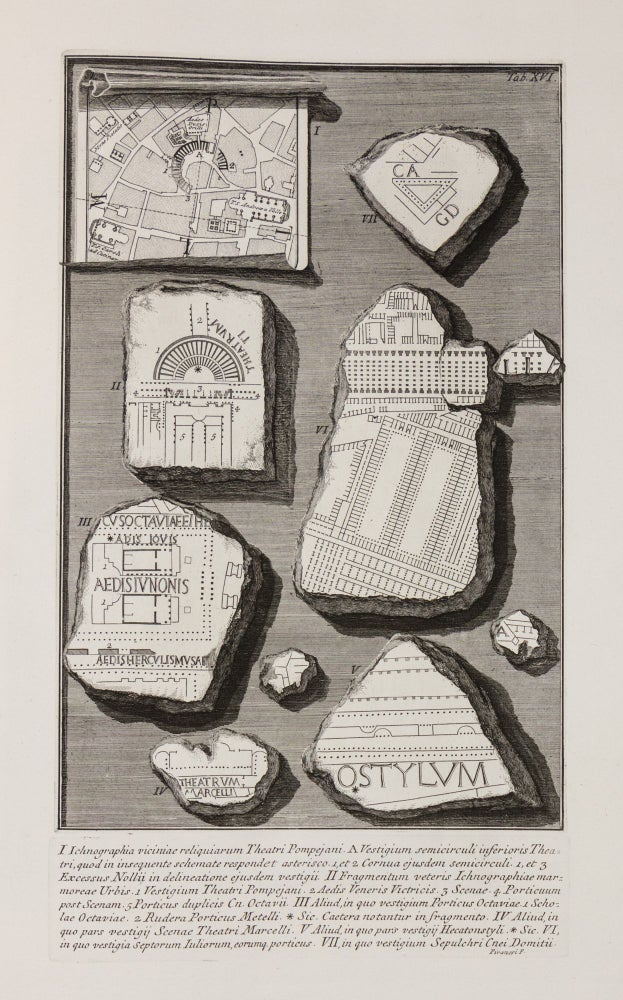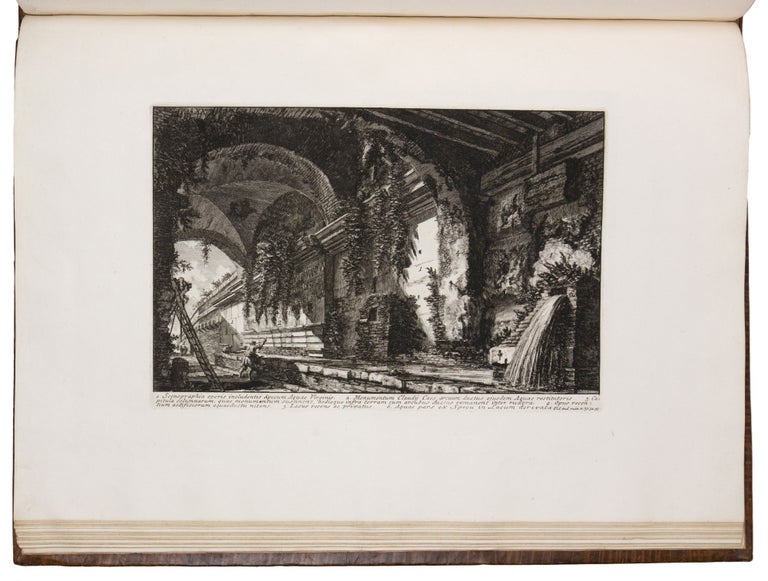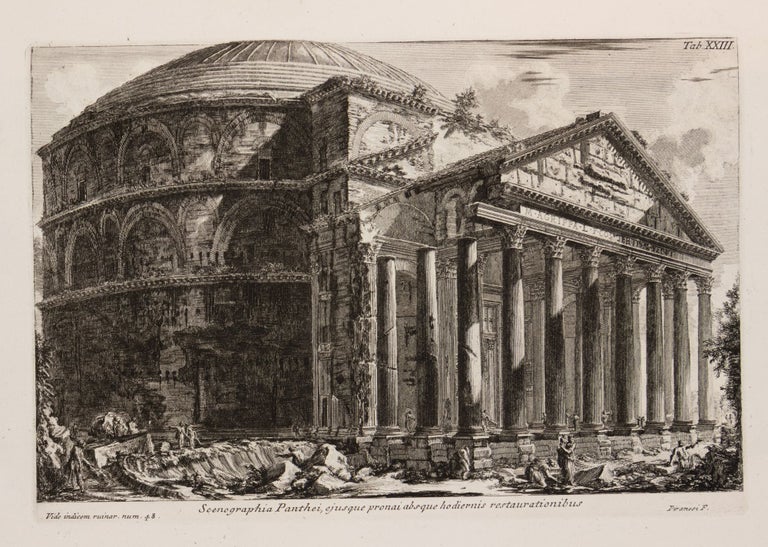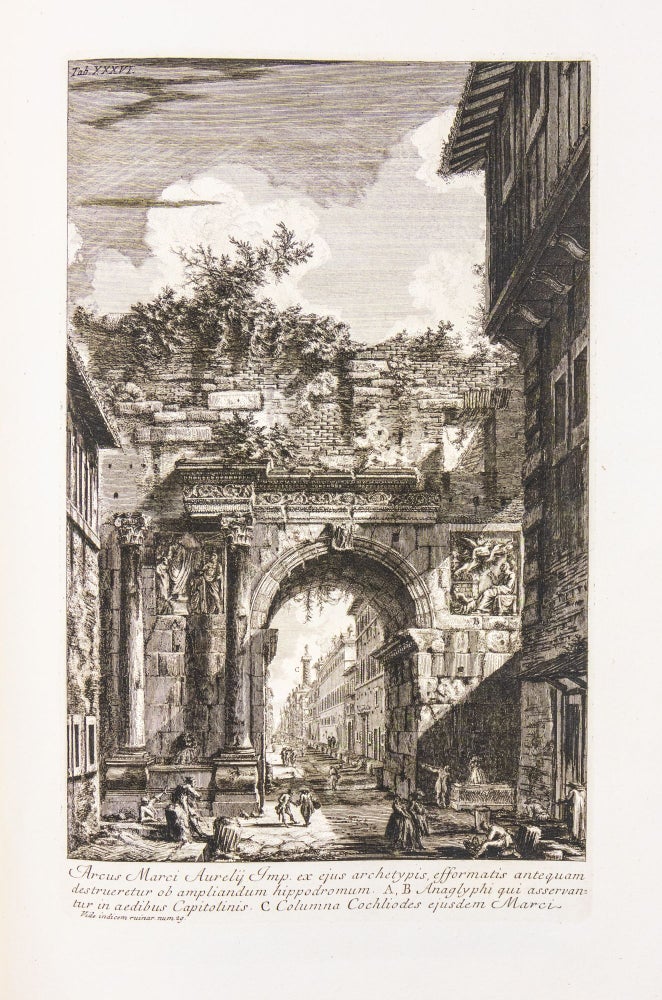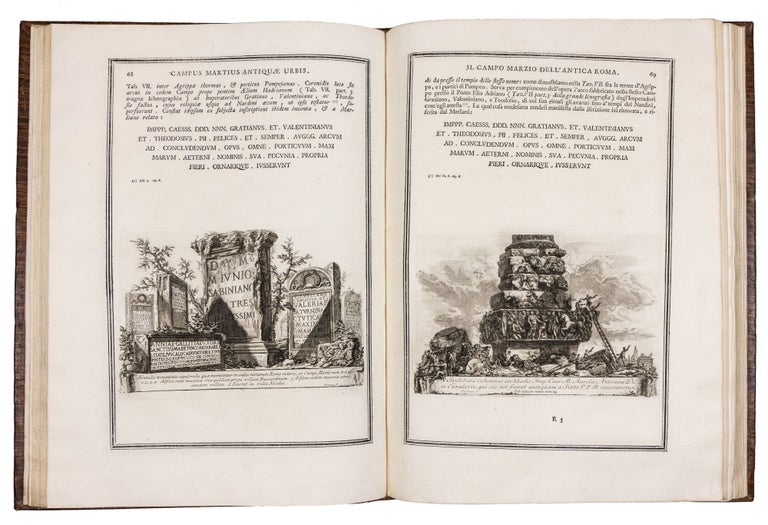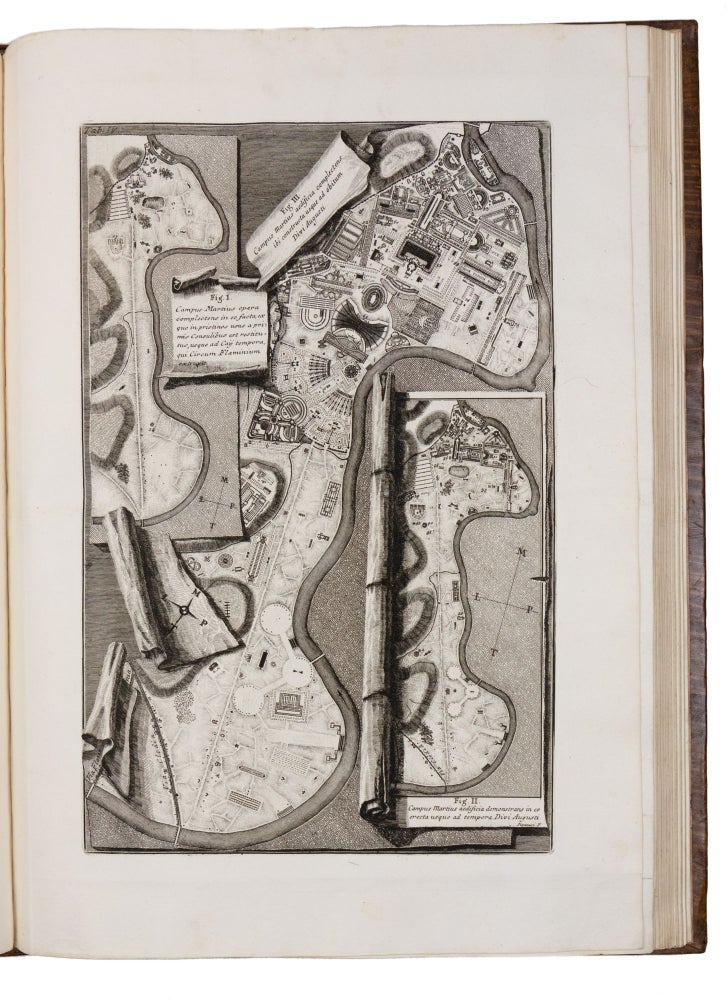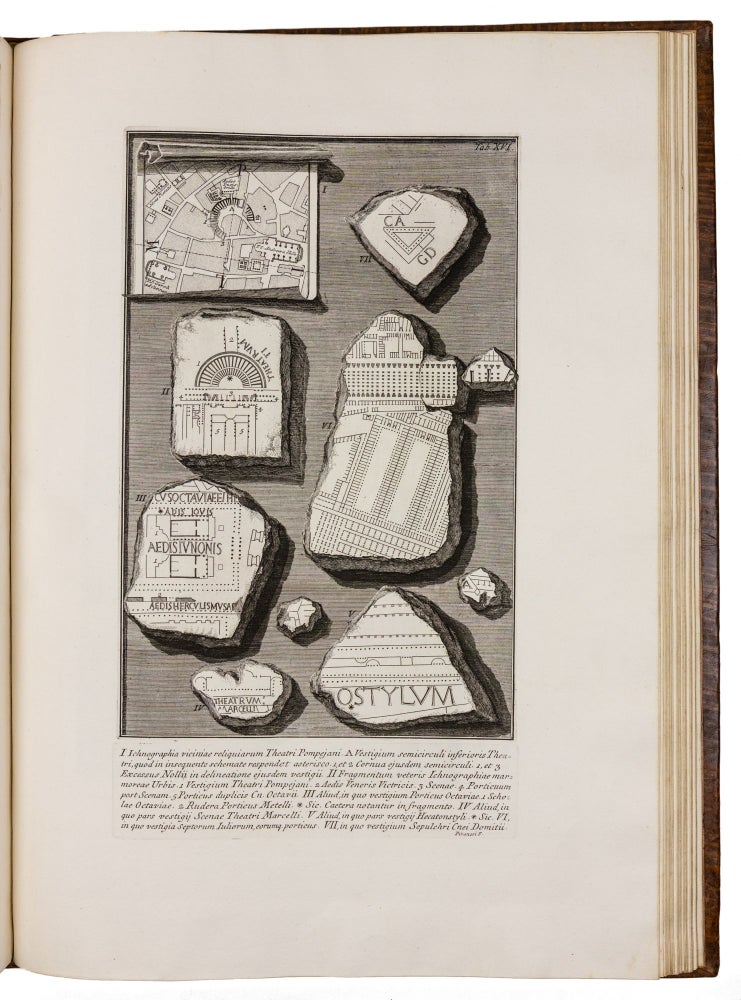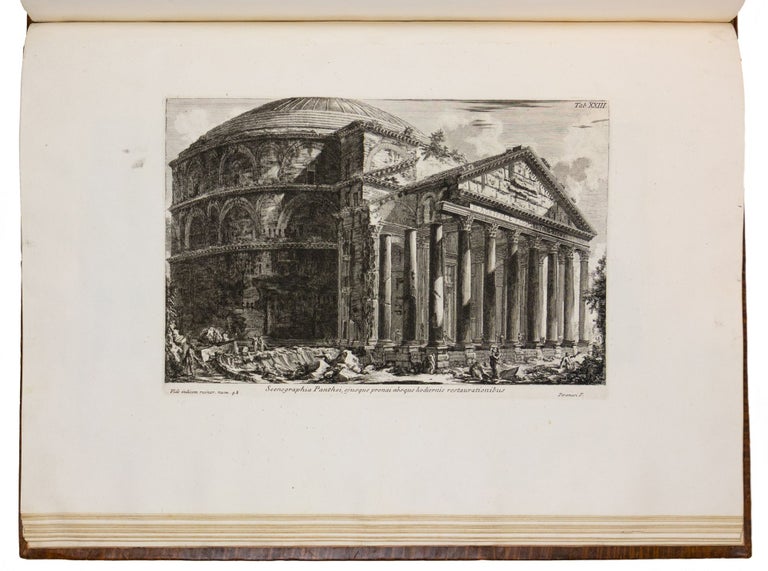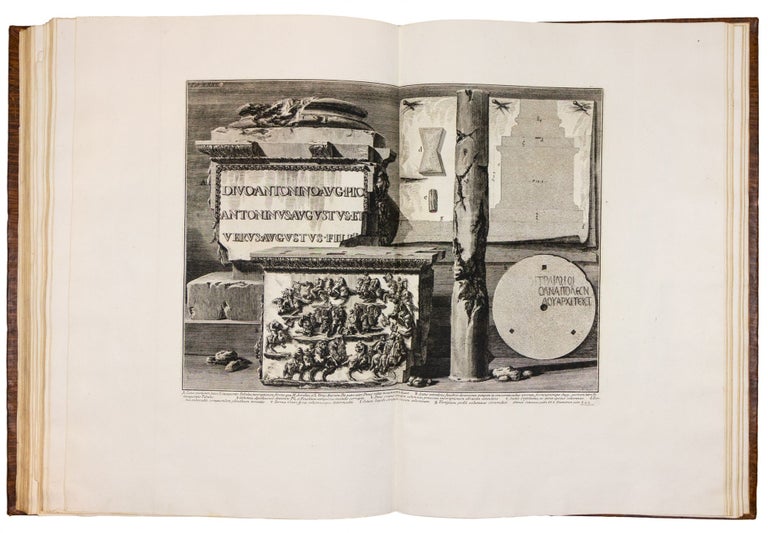Campvs Martivs Antiqvae Vrbis Romae MDCCLXII
Rome: Giovanni Battista Piranesi, 1762.
Price: $84,000.00
Folio: 57 x 41.4 cm. Pagination [viii], 69, [i], xii, xvii, [i] pp., [2] etched title plates, 48 etched plates (2 folding, 1 double page). Collation of text lvs.: a-b2, A-Q2, R3, a-c2, *2-***2, π1.
FIRST EDITION.
An extremely fine copy of the first edition, bound in a fabulous contemporary Baroque binding by an unidentified Roman binder. Binding and contents in excellent condition. Binding with light wear at the hinges, contents extremely fresh with dark, rich impressions of the plates. There is a little damp-staining to the lower corner of the opening leaves (and a few other leaves further on in the book), a few instances of light marginal spotting, a stray smudge or two. There are some clean tears or splits (without loss) at some folds of the massive folding plate.
The Binding:
Contemporary mottled calf, richly gilt, the boards with elaborate rococo borders, tooled with flowers, scrolling foliage, and ornate shell ornaments. The binding is in excellent condition with very minor wear. For an identical binding, see The Frank H. Kessner Collection of Books on Rome, Christie, Manson & Woods, (4-5 Oct. 1990, Lot 447, p. 206-7). For a set of works by Piranesi, including the Campus Martius, bound in very similar contemporary bindings and given as a gift by the Venetian Pope Clement XIII to the Republic of Venice (and presumably his friend the Doge Marco Foscarini), see “Piranesi. Incisioni, Rami, Legature, Architetture”, Alessandro Bettagno, editor (1978), p. 76-77, and (for the images), p. 427 and 428.
Contents: pp. [i] blank; [ii-vii] dedication by Piranesi to Robert Adam, in Latin (on versos) and Italian (on rectos); [viii] blank; [i] approbation, dated Rome, 16 June 1761, with two imprimaturs; 2-69 text, in Latin (on versos) and Italian (on rectos), printed within a triple line border; [70] blank; i-xii key to plans of the Campus Martius on plates iii-iv, Latin and Italian in parallel columns; i-xvii index of monuments on the large map of the Campo Marzio (plates V-X), Latin and Italian in parallel columns; [xviii] blank.
Ornaments: Etched headpiece on Latin dedication with view of "Sepulchrum Mariae Honorij Imp. Uxoris . . "etched headpiece on Italian dedication with view of "Labrum aegyptiacum porphyreticum . . .," signed "Piranesi F"; etched tailpiece with group of monuments captioned "Nonnulla monumenta sepulcralia . . ."(p. 68), signed "Piranesi F"; etched tailpiece showing a "Stylobata columnae" (p. 69), signed "Piranesi F"; etched initial *A" incorporating quiver, arrows set against a relief of trophies (p. 2); etched initial "D" with decorated belt and trophies (p. 3)
Illustrations: Etched, engraved, and drypoint title plate with title incised on cracked stone tablet, surrounded by fragments including broken column bearing dedication to Robert Adam: "Roberto Adam Britanno Architecto Celebérrimo"; added etched title plate with bird's-eye view of reconstructed Campo Marzio with title in Italian: "II Campo Marzio Dell’Antica Roma Opera Di G.B. Piranesi Socio Delia Real Società Degli Antiqvari Di Londra"; and 52 etched, engraved, and drypoint coppers on 48 plates numbered I-XLVIII (plates XII and XLVI each with additional unnumbered plate on the sheet; plate XLVII with two additional unnumbered plates on the sheet; plates II and
XXXI folding, both printed from two coppers; plate XXXII double page; remainder full page). Plates V-X are joined together to form the enormous folding map. Plates XV-XIX, XXI, XXVI-XXIX, XXXV, XLII, XLIII with captions printed on separate plates. Most plates with Piranesi's signature ("Piranesi F/'). Plate XXXI, "Scenographia Machinae” is signed by Francesco Fontana as designer and draftsman and by Arnold van Westerhout as engraver (“Aeques Fran.cus Fontana Inuen; et delin."; “Arnoldus Van Westerhout Antuerp.s... Sculpsit"), and must have been prepared before 1725, the year of van Westerhout's death.”(Millard Catalogue)
“The ‘Campo Marzio’ was published by Piranesi in 1762 with two frontispieces (in Latin and Italian) and fortyeight plates. The publication borrows from the two main interests of the author, the archaeological research and the polemical battles of the early 1760s. His historical inquiry is here committed to supporting his view of the primacy and genius of Roman builders. This work originated in the 1750s and is dedicated to Robert Adam, who befriended Piranesi during his Grand Tour visit of Rome. Adam witnessed Piranesi' s engraving of the imperial plan of Rome in 1755, eventually stretching over six copperplates. This plan is one of Piranesi's most feverish fantasies, marshaling a huge range of imaginary constructs for the celebration of ancient Rome. Within this plan he proposes an urban and architectural landscape of the utmost complexity. Piranesi achieves this tour de force through a great variety of illustrations and employs every means of representation at his disposal. This project allows him to display his knowledge of cartography in the making of the ichnographic plan of the reconstructed ancient city. He had earlier worked with the cartographer Giovanni Battista Nolli, the author of the plan of contemporary Rome published in 1748.
“Nolli's plan was not only accurately surveyed but also pioneered a mode of representation technically known as figure-ground, which allowed the clarity and accuracy of the plan to be appreciated visually. Piranesi also relied on archaeological reconstruction and landscape illustration in the making of the plates in the Campo Marzio series. The plates illustrate the buildings in this part of Rome, stretching into both bends of the Tiber, since Piranesi interprets the Campo Marzio as the valley between the Roman hills, including the area north of the Porta del Popolo, richly endowed with public and military structures.
“In this publication, Piranesi refined his method of graphic juxtaposition. The Campo Marzio opens with a great plan of Rome with stone fragments illusionistically "placed" on it; subsequently sheets of details are "pinned" onto larger plans and views. Thus Piranesi uses trompe l' oeil to juxtapose differently scaled drawings. He reconstructs the foundation of the Tiber island as a ship, and he uses parts of the Forma Urbis to aid his own reconstruction of the area around the contemporary Palazzo Pio built onto the remains of the theater of Pompei. He practices, throughout, an X-ray vision that enables him to locate the extant fragments of ancient ruins within existing modern buildings, such as the church of Santa Maria in Via Lata. He is no longer merely illustrating but re-creating a lost world, which perhaps helps to explain the disorientation of his figures. His innovation then, as Wilton-Ely (1994) has summarized, is to show the ruins as a view rather than merely offering a dry archaeological reconstruction. The reconstruction of the buildings in the Campo Marzio is based on accurate sources and also on the architectural fantasies of Piranesi' s earlier production. He illustrates, for instance, the splendid arch of Marcus Aurelius known as the Arco di Portogallo, which had been demolished under Alexander VII in the midseventeenth century; as an extant monument, while his theater of Marcellus is shown as a ruin rather than the proud family palace it had become since the High Renaissance.”(p. 312-313).
References: Millard Italian no. 91; Focillon 428-479; Hind, Piranesi, 85; Piranesi: Complete Etchings, 559-612; RIBA, Early Punted Books, 2551; On Piranesi, Millard p. 297 ff.


